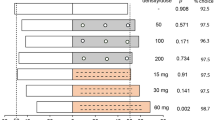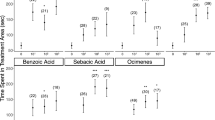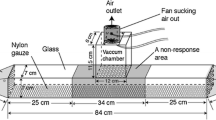Abstract
Studies of Varroa destructor orientation to honey bees were undertaken to isolate discrete chemical compounds that elicit host-finding activity. Petri dish bioassays were used to study cues that evoked invasion behaviour into simulated brood cells and a Y-tube olfactometer was used to evaluate varroa orientation to olfactory volatiles. In Petri dish bioassays, mites were highly attracted to live L5 worker larvae and to live and freshly freeze-killed nurse bees. Olfactometer bioassays indicated olfactory orientation to the same type of hosts, however mites were not attracted to the odour produced by live pollen foragers. The odour of forager hexane extracts also interfered with the ability of mites to localize and infest a restrained nurse bee host. Varroa mites oriented to the odour produced by newly emerged bees (<16 h old) when choosing against a clean airstream, however in choices between the odours of newly emerged workers and nurses, mites readily oriented to nurses when newly emerged workers were <3 h old. The odour produced by newly emerged workers 18–20 h of age was equally as attractive to mites as that of nurse bees, suggesting a changing profile of volatiles is produced as newly emerged workers age. Through fractionation and isolation of active components of nurse bee-derived solvent washes, two honey bee Nasonov pheromone components, geraniol and nerolic acid, were shown to confuse mite orientation. We suggest that V. destructor may detect relative concentrations of these compounds in order to discriminate between adult bee hosts, and preferentially parasitize nurse bees over older workers in honey bee colonies. The volatile profile of newly emerged worker bees also may serve as an initial stimulus for mites to disperse before being guided by allomonal cues produced by older workers to locate nurses. Fatty acid esters, previously identified as putative kairomones for varroa, proved to be inactive in both types of bioassays.
Similar content being viewed by others
References
D. Anderson J.W. Trueman (2000) ArticleTitle Varroa jacobsoni (Acari: Varroidae) is more than one species Exp. Appl. Acarol. 24 165–189 Occurrence Handle10.1023/A:1006456720416 Occurrence Handle11108385
P. Aumeier P. Rosenkranz W. Francke (2002) ArticleTitleCuticular volatiles, attractivity of worker larvae and invasion of brood cells by Varroa mites. A comparison of Africanized and European honey bees Chemoecology 12 65–75 Occurrence Handle10.1007/s00049-002-8328-y
Baird D.S. 2001. Semiochemical studies on the red imported fire ant (Solenopsis invicta), the tarnished plant bug (Lygus lineolaris) and the varroa mite (Varroa destructor). Ph.D. Dissertation, Simon Fraser University, Burnaby, BC, Canada130 pp.
J. Baxter F. Eischen J. Pettis W.T. Wilson H. Shimanuki (1998) ArticleTitleDetection of fluvalinate-resistant varroa mites in U.S. honey bees Am. Bee. J. 138 291
R. Boch D.A. Shearer (1963) ArticleTitleProduction of geraniol by bees of different ages J. Ins. Physiol. 9 431–434 Occurrence Handle10.1016/0022-1910(63)90052-0
R. Boch D.A. Shearer (1964) ArticleTitleIdentification of nerolic and geranic acids in the Nasanoff pheromone of the honey bee Nature 202 320–321
S. Bogdanov V. Kilchenmann A. Imdorf (1998) ArticleTitleAcaricide residues in some bee products J. Apic. Res. 37 57–67
W.J. Boot (1994) ArticleTitleMethyl palmitate does not elicit invasion of honeybee brood cells by Varroa mites Exp. Appl. Acarol. 18 587–192 Occurrence Handle10.1007/BF00051721
W.J. Boot J.N.M. Calis J. Beetsma (1991) ArticleTitleInvasion of varroa mites into honeybee brood cells; when do cells attract Varroa mites? Proc. Exp. Appl. Entomol. N.E.V. Amsterdam 2 154–156
W.J. Boot J.N.M. Calis J. Beetsma (1992) ArticleTitleDifferential periods of Varroa mite invasion into worker and drone cells of honey bees Exp. Appl. Acarol. 16 295–301 Occurrence Handle10.1007/BF01218571
W.J. Boot J.N.M. Calis J. Beetsma (1995b) ArticleTitleDoes time spent on adult bees affect reproductive success of Varroa mites? Entomol. Exp. Appl. 75 1–7
W.J. Boot J. Schoenmaker J.N.M. Calis J. Beetsma (1995a) ArticleTitleInvasion of Varroa jacobsoni into drone brood cells of the honey beeApis mellifera Apidologie 26 109–118
W.A. Bruce (1997) ArticleTitleUse of infrared detection for host location by the bee-miteVarroa jacobsoni (Acari: Varroidae): a theoretical model Int. J. Acarol. 23 7–11
W.A. Bruce G.R. Needham W.J.E. Potts (1997) ArticleTitleThe effects of temperature and water vapor activity on water loss by Varroa jacobsoni (Acari: Varroidae) Am. Bee J. 137 461–463
N.W. Calderone S. Lin (2001) ArticleTitleBehavioural responses of Varroa destructor (Acari: Varroidae) to extracts of larvaecocoons and brood food of worker and drone honey bees, Apis mellifera (Hymenoptera: Apidae) Physiol. Entomol. 26 341–350 Occurrence Handle10.1046/j.0307-6962.2001.00254.x
N.W. Calderone S. Lin L.P.S. Kuenen (2002) ArticleTitleDifferential infestation of honey beeApis melliferaworker and queen brood by the parasitic mite Varroa destructor Apidologie 33 389–398 Occurrence Handle10.1051/apido:2002024
M.E. Colin R. Vandame P. Jourdan S. Di Pasquale (1997) ArticleTitleFluvalinate resistance of Varroa jacobsoni Oudemans (Acari: Varroidae) in Mediterranean apiaries of France Apidologie 28 375–384
M de Greef L. de Wael O. van Laere (1994) ArticleTitleBestimmung der Rückstände von Fluvalinat in belgischem Honig und Bienenwachs Allg. Dtsch. Imkerztg. 7 7–8
L.I. de Guzman T.T. Rinderer L.D. Beaman (1993) ArticleTitleSurvival of Varroa jacobsoni Oud. (Acari:Varroidae) away from its living host Apis mellifera L Exp. Appl. Acarol. 17 283–290
D. de Jong (1997) Mites: varroa and other parasites of brood R.A. Morse K. Flottum (Eds) Honey Bee Pests, Predators, and Diseases, 3rd ed A.I. Root MedinaOH, USA 279–327
A. de Ruijter (1987) ArticleTitleReproduction of Varroa jacobsoni during successive brood cycles of the honeybee Apidologie 18 321–326
G. Donzé S. Schnyder-Candrian S. Bogdanov P.-A. Diehl P.M. Guerin V. Kilchenman F. Monachon (1998) ArticleTitleAliphatic alcohols and aldehydes of honey bee cocoon induce arrestment behavior in Varroa jacobsoni (Acari: Mesostigmata), an ectoparasite of Apis mellifera Arch. Insect Biochem. Physiol. 37 129–145 Occurrence Handle10.1002/(SICI)1520-6327(1998)37:2<129::AID-ARCH2>3.0.CO;2-P
P.J. Elzen D. Westervelt (2002) ArticleTitleDetection of coumaphos resistance in Varroa destructor in Florida Am. Bee J. 142 291–292
P.J. Elzen J.R. Baxter M. Spivak W.T. Wilson (1999a) ArticleTitleAmitraz resistance in varroa: new discovery in North America Am. Bee J. 139 362
P.J. Elzen F.A. Eischen J.R. Baxter J. Pettis G.W. Elzen W.T. Wilson (1998) ArticleTitleFluvalinate resistance in Varroa jacobsoni from several geographic locations Am. Bee J. 138 674–676
P.J. Elzen F.A. Eischen J.R. Baxter J. Pettis G.W. Elzen W.T. Wilson (1999b) ArticleTitleDetection of fluvalinate resistance in US Varroa jacobsoni Oud. (Mesostigmata: Varroidae) to the acaricide fluvalinate Apidologie 30 13–17
I. Fries H. Wei W. Shi S.J. Chen (1996) ArticleTitleGrooming behavior and damaged mites (Varroa jacobsoni) in Apis cerana cerana Apis mellifera ligustica Apidologie 27 3–11
S. Fuchs (1990) ArticleTitlePreference for drone brood cells by Varroa jacobsoni Oud in colonies of Apis mellifera carnica Apidologie 21 193–199
H. Hansen J.H. Petersen (1988) ArticleTitleResidues in honey and wax after treatment of bee colonies with bromopropylate Dan. J. Plant Soil Sci. 92 1–6
J.L. Harris (1979) ArticleTitleA rapid method for colour-marking single honeybees with fluorescent paint J. Apic. Res. 18 201–203
H. Hoppe W. Ritter (1988) ArticleTitleThe influence of the nasonov pheromone on the recognition of house bees and foragers by Varroa jacobsoni Apidologie 19 165–172
M.D. Infantidis (1988) ArticleTitleSome aspects of the process of Varroa jacobsoni mite entrance into honey bee (Apis mellifera) brood cells Apidologie 19 387–396
B. Kraus (1990) ArticleTitleEffects of honey-bee alarm pheromone compounds on the behaviour of Varroa jacobsoni Apidologie 21 127–134
B. Kraus (1993) ArticleTitlePreferences of Varroa jacobsoni for honey bees (Apis mellifera L.) of different ages J. Apic. Res. 32 57–64
B. Kraus (1994) ArticleTitleFactors influencing host choice of the honey bee parasite Varroa jacobsoni Oud Exp. Appl. Acarol. 18 435–443 Occurrence Handle10.1007/BF00051525
B. Kraus N. Koeniger S. Fuchs (1986) ArticleTitleUnterscheidung zwischen Bienen verschiedenen Alters durch Varroa jacobsoni Oud. und Bevorzugung von Ammenbienen im Sommerbienenvolk Apidologie 17 257–266
L.P.S. Kuenen N.W. Calderone (1997) ArticleTitleTransfers of Varroa mites from newly emerged bees: preferences for age- and function-specific adult bees (Hymenoptera: Apidae) J. Ins. Behav. 10 213–228
Y. Le Conte G. Arnold (1987) ArticleTitleInfluence de l’age des abeilles (Apis mellifica L.) et de la chaleur sur le comportement de Varroa jacobsoni Oud Apidologie 18 305–320
Y. Le Conte G. Arnold (1988) ArticleTitleÉtude du thermopréférendum de Varroa jacobsoni Oud Apidologie 19 155–164
Y. Le Conte G. Arnold J. Trouiller C. Masson B. Chappe G. Ourisson (1989) ArticleTitleAttraction of the parasitic mite Varroa to the drone larvae of honey bees by simple aliphatic esters Science 245 638–639
Y. Le Conte G. Arnold J. Trouiller C. Masson B. Chappe (1990) ArticleTitleIdentification of a brood pheromone in honeybees Naturwissenschaften 77 334–336 Occurrence Handle10.1007/BF01138390
M.N. LeDoux S.F. Pernal H.A. Higo M.L. Winston (2000) ArticleTitleDevelopment of a bioassay to test the orientation behaviour of the honey bee ectoparasiteVarroa jacobsoni J. Apic. Res. 39 43–51
M. Lodesani M. Colombo M. Spreafico (1995) ArticleTitleIneffectiveness of Apistan® treatment against the mite Varroa jacobsoni Oud in several districts of Lombardy (Italy) Apidologie 26 67–72
M. Lodesani A. Pellacani S. Bergomi E. Carpana T. Rabitti P. Lasagni (1992) ArticleTitleResidue determination for some products used against Varroa infestation in bees Apidologie 23 257–272
C. Martin M. Salvy E. Provost A.-G. Bagnères M. Roux D. Crauser J.-L. Clement Y. Le Conte (2001) ArticleTitleVariations in chemical mimicry by the ectoparasitic mite Varroa jacobsoni to the developmental stage of the host honey-bee Apis mellifera Ins. Biochem. Molec. Biol. 31 365–379 Occurrence Handle10.1016/S0965-1748(00)00130-2
A. Matheson (1993) ArticleTitleWorld bee health report Bee World 74 176–212
A. Matheson (1995) ArticleTitleWorld bee health update Bee World 76 31–39
N. Milani (1999a) ArticleTitleThe resistance of Varroa jacobsoni Oud. to acaricides Apidologie 30 229–234
Milani N. 1999b. The resistance against acaricides: a worrying problem in the control of Varroa jacobsoni. In: Proceedings of Apimondia '99. XXXVI Congress of the International Federation of Beekeepers' Associations, Sept. 1999. VancouverBC, Canadapp. 57–58.
F. Nazzi N. Milani G. Della Vedova M. Nimis (2001) ArticleTitleSemiochemicals from larval food affect the locomotory behaviour of Varroa destructor Apidologie 32 149–155 Occurrence Handle10.1051/apido:2001120
Y.-S. Peng S. Fang S. Xu L. Ge (1987a) ArticleTitleThe resistance mechanism of the Asian honey beeApis cerana Fabr., to an ectoparasitic miteVarroa jacobsoni Oudemans J. Invert. Pathol. 49 54–60 Occurrence Handle10.1016/0022-2011(87)90125-X
Y.-S. Peng S. Fang S. Xu L. Ge M.E. Nasr (1987b) ArticleTitleResponse of foster Asian honeybee (Apis cerana Fabr.) colonies to the brood of European honeybee (Apis mellifera L.) infested with parasitic miteVarroa jacobsoni Oudemans J. Invert. Pathol. 49 259–264 Occurrence Handle10.1016/0022-2011(87)90125-X
J.A. Pickett I.H. Wiliams A.P. Martin M.C. Smith (1980) ArticleTitleNasonov pheromone of the honey beeApis mellifera L. (Hymenoptera: Apidae). Part I. Chemical characterisation J. Chem. Ecol. 6 425–434 Occurrence Handle10.1007/BF01402919
J.A. Pickett I.H. Wiliams M.C. Smith A.P. Martin (1981) ArticleTitleNasonov pheromone of the honey beeApis mellifera L. (Hymenoptera: Apidae). Part III. Regulation of pheromone composition and production J. Chem. Ecol. 7 543–54 Occurrence Handle10.1007/BF00987702
M. Rickli P.A. Diehl P.M. Guerin (1994) ArticleTitleCuticle alkanes of honeybee larvae mediate arrestment of bee parasite J. Chem. Ecol. 20 2437–2453 Occurrence Handle10.1007/BF02033212
M. Rickli P.M. Guerin P.A. Diehl (1992) ArticleTitlePalmitic acid released from honeybee worker larvae attracts the parasitic mite Varroa jacobsoni on a servosphere Naturwissenschaften 79 320–322 Occurrence Handle10.1007/BF01138711
P. Rosenkranz (1993) ArticleTitleA bioassay for the investigation of host-finding behavior in Varroa jacobsoni Apidologie 24 486–488
Y. Slabezki H. Gal Y. Lensky (1991) ArticleTitleThe effect of fluvalinate applications in bee colonies on population levels of Varroa jacobsoni and honey bees (Apis mellifera L.) and on residues in honey and wax BeeScience 1 189–195
M. Spreafico F.R. Eördegh I. Bernardinelli M. Colombo (2001) ArticleTitleFirst detection of strains of Varroa destructor resistant to coumaphos. results of laboratory tests and field trials Apidologie 32 49–55 Occurrence Handle10.1051/apido:2001110
H.M. Thompson M.A. Brown R.G. Ball M.H. Bew (2002) ArticleTitleFirst report of Varroa destructor resistance to pyrethroids in the UK Apidologie 33 357–366 Occurrence Handle10.1051/apido:2002027
J. Trouiller G. Arnold B. Chappe Y. Le Conte C. Masson (1992) ArticleTitleSemiochemical basis of infestation of honey bee brood by Varroa jacobsoni J. Chem. Ecol. 18 2041–2053 Occurrence Handle10.1007/BF00981926
J. Trouiller G. Arnold Y. Le Conte C. Masson (1991) ArticleTitleTemporal pheromonal and kairomonal secretion in the brood of honeybees Naturwissenschaften 78 368–370 Occurrence Handle10.1007/BF01131612
N.W.M. van Buren J. Mariën H.H.W. Velthuis R.C.H.M. Oudejans (1992) ArticleTitleResidues in beeswax and honey of Perizin, and acaricide to combat the mite Varroa jacobsoni Oudemans (Acari: Mesostigmata) Environ. Entomol. 21 860–865
L.E.M. Vet J.C. van Lenteren M. Heymans E. Meelis (1983) ArticleTitleAn airflow olfactometer for measuring olfactory responses of hymenopterous parasitoids and other small insects Physiol. Entomol. 8 97–106
K. Wallner (1995) ArticleTitleThe use of varroacides and their influence on the quality of bee products Am. Bee. J. 135 817–821
K. Wallner (1999) ArticleTitleVarroacides and their residues in bee products Apidologie 30 235–248
H.P. Wendel P. Rosenkranz (1990) ArticleTitleRates of invasion and fertility of Varroa females during successive reproductive cycles Apidologie 21 372–374
M.L. Winston (1987) The Biology of the Honey Bee Harvard Univ. Press CambridgeMAUSA
J.A. Yoder D. Sammataro J.A. Peterson G.R. Needham W.A. Bruce (1999) ArticleTitleWater requirements of adult females of the honey bee parasitic miteVarroa jacobsoni (Acari: Varroidae) and implications for control Int. J. Acarol. 25 329–335
K. Zetlmeisl P. Rosenkranz (1994) ArticleTitleVarroa females in a bioassay: host recognition of honey-bee larvae and adult bees Apidologie 25 507–508
Author information
Authors and Affiliations
Corresponding author
Rights and permissions
About this article
Cite this article
Pernal, S., Baird, D., Birmingham, A. et al. Semiochemicals Influencing the Host-finding Behaviour of Varroa Destructor. Exp Appl Acarol 37, 1–26 (2005). https://doi.org/10.1007/s10493-005-1117-x
Received:
Accepted:
Issue Date:
DOI: https://doi.org/10.1007/s10493-005-1117-x




